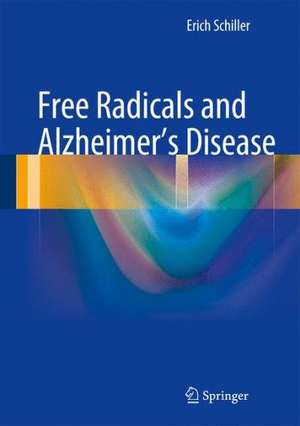Free Radicals and Alzheimer's Disease
Autor Erich Schilleren Limba Engleză Hardback – 31 oct 2015
Preț: 1041.79 lei
Preț vechi: 1096.62 lei
-5% Nou
Puncte Express: 1563
Preț estimativ în valută:
199.39€ • 215.23$ • 167.19£
199.39€ • 215.23$ • 167.19£
Carte nepublicată încă
Doresc să fiu notificat când acest titlu va fi disponibil:
Se trimite...
Preluare comenzi: 021 569.72.76
Specificații
ISBN-13: 9783642318054
ISBN-10: 3642318053
Pagini: 510
Ilustrații: 614 schwarz-weiße und 7 farbige Abbildungen
Dimensiuni: 155 x 254 mm
Ediția:2014
Editura: Springer Verlag GmbH
Locul publicării:Berlin, Heidelberg, Germany
ISBN-10: 3642318053
Pagini: 510
Ilustrații: 614 schwarz-weiße und 7 farbige Abbildungen
Dimensiuni: 155 x 254 mm
Ediția:2014
Editura: Springer Verlag GmbH
Locul publicării:Berlin, Heidelberg, Germany
Public țintă
Professional/practitionerCuprins
Oxidative Damage in Neurodegenerative Diseases.- Nitrosative Stress in Alzheimer’s Disease.- The Cholinergic System in Alzheimer’s Disease.- Immunology and Immunotherapy in Alzheimer’s Disease.- Animal Models.- In vitro Models.- The Term “radical”.- Nucleus.- Mitochondria.- Peroxisomes.- Endoplasmic Reticulum.- Golgi Apparatus.- Lysosomes.- Multivesicular Bodies.- Cytoskeleton.- Synapses.- Enzymes.- Lipids and Lipoids.- Lectin Histochemistry.- Metal ion Homeostasis.- Hormonal Influences.- The Nerve Cell.- Glial-Neuronal Interactions.- Microglial Cells.- Astrocytes.- Oligodendrocytes.- Angiogenesis Signaling.- Receptors.- Adenosine Receptors.- Peptide Hormones and their Receptors.- Glutamate Receptors.- Kainic Acid Receptors.- Delta Receptors.- α-Amino-3-hydroxy-5-methyl-4-isoxazolepropionic acid (AMPA).- Serotonin.- Melatonin Receptors.- Cannabinoid Receptors.- Interleukin-6 Receptors.- Glutamate Rransporters.- GABA Transporters.- Serotonin Transporter.- Pathoclisis.- Hypothalamic-pituitary-adrenal Axis Dysfunction.- Thyroid.- Thymus.- Liver.- Intestine.- Pancreas.- Kidney.
Notă biografică
Erich K.P. Schiller was born in Hamburg in 1922. In 1940 he became a student of Max Clara, Wolfgang Bargmann and Richard Arwed Pfeifer, and later gained his Medical License at the University of Leipzig and his MD at the University of Essen. For a long period he was involved in research into silicosis at Rheinpreussen Mining Company before joining the Institute of Hygiene and Occupational Medicine at the University of Essen. He then became Head of Experimental Pathology at Cassella Co, Frankfurt and subsequently worked at the Department of Pharmacology and Toxicology, University of Heidelberg, Mannheim and the German Cancer Research Centre, Heidelberg. Dr. Schiller is a member of a number of prestigious societies, including the Anatomische Gesellschaft, the Deutsche Gesellschaft für Pathologie (German Society of Pathology) and the Pathological Society of Great Britain and Ireland. He has published extensively in the German, English and French languages and is the author of Free Radicals and Inhalation Pathology, published in 2004. Dr. Schiller was selected for inclusion in the volume Outstanding People of the 21st Century published by the International Biographical Centre.
Textul de pe ultima copertă
Accumulating evidence suggests that oxidative and nitrosative stress plays a major role in the initiation and progression of Alzheimer’s disease. This monograph aims to examine in depth and to clarify the role of oxygen- and nitrogen-centred radicals in the pathogenesis of the disease. To this end, cultures of neuronal and glial cells were challenged with amyloid β1–40 and β25–35 peptides and photon emission was continuously measured with the luminol- or lucigenin-amplified chemiluminescence technique in order to demonstrate free radical species. Furthermore, brain slices of hypoxic rats or rats treated with nitric oxide donors were analysed by transmission electron microscopy. The book also pays due attention to the use of free radical scavengers as prophylactic agents and to the potential therapeutic role of iron and copper chelators. The author’s own detailed research is complemented by an exhaustive analysis of the relevant literature, with the citation of more than 9000 publications. Free Radicals and Alzheimer’s Disease will be a fascinating and invaluable source of information for researchers and clinicians.
Caracteristici
Examines in detail the role of oxygen- and nitrogen-centred radicals in the pathogenesis of Alzheimer’s diseaseBased on the author’s own detailed research and an exhaustive analysis of the literature, with the citation of more than 9000 publicationsInvaluable source of information for researchers and clinicians
Descriere
This book examines the role of oxygen- and nitrogen-centred radicals in the pathogenesis of the disease. Pays detailed attention to the use of free radical scavengers as prophylactic agents and the potential therapeutic role of iron and copper chelators.
